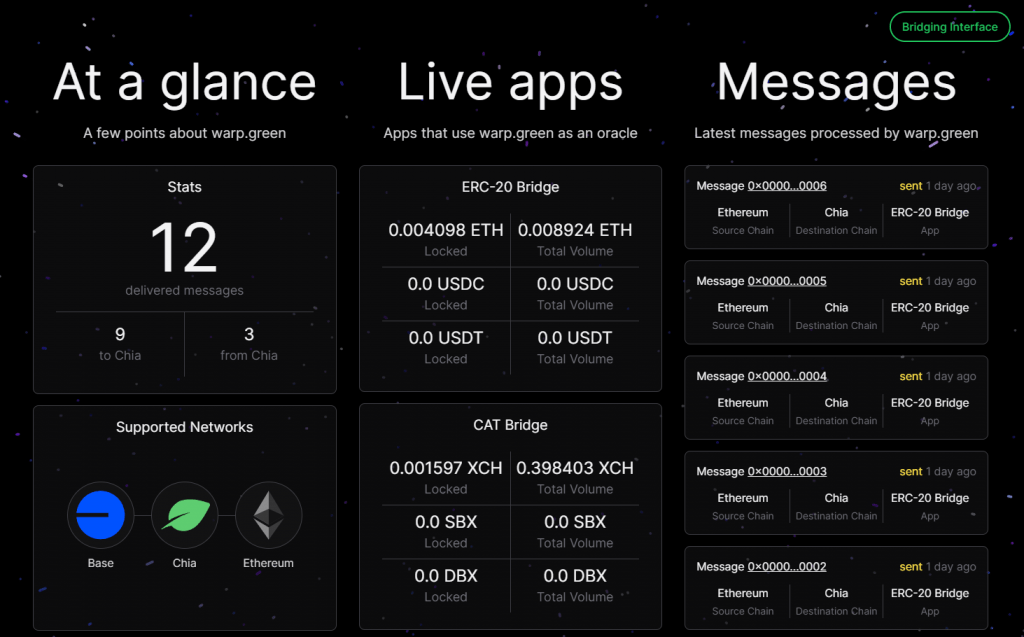The much anticipated “ETH-XCH Bridge” is around the corner and I had previously shared some updates about the development and timelines. Since then, I’ve learned more about how it works through the newly published and very comprehensive developer docs. Here are some takeaways and a sneak peek of their website.
warp.green is not a bridge

warp.green itself is a cross-chain messaging protocol to allow sending messages between blockchains (e.g. Eth/Base to Chia and vice versa). The ability to communicate between two chains in a secure and verifiable way is the core enabler of a bridge — in other words, a bridge needs an oracle to dictate what action should be taken on either side and warp.green is that oracle.
A bridge itself is an app that integrates the warp.green protocol. Initially there will be two bridge apps available at launch but other apps could be built in the future leveraging the same protocol for other use cases.
There are 2 bridge apps: ERC-20 Bridge and CAT Bridge
- ERC-20 Bridge: Wrapping Ethereum/Base assets on Chia, e.g. milliETH on Chia
- CAT Bridge: Wrapping Chia assets on Ethereum/Base, e.g. WXCH on Ethereum
Note that both bridges also support unwrapping assets back in the other direction. Because the mechanism for locking assets and minting are so different on the two chains, it makes sense for these two bridges to be separate apps.

Native ETH won’t be bridged directly, milliETH will be minted and bridged instead.
As the name suggests, the ERC-20 Bridge bridges ERC-20 assets and doesn’t support native ETH. Although technically the WETH ERC-20 token could be supported, the warp.green team decided to create a new ERC-20 token called milliETH instead. This contract works the same as the widely used WETH contract but instead issues milliETH at a rate of 1 milliETH = 0.001 ETH. This will allow finer precision when wrapped as a CAT since the current CAT standard only supports 3 decimal places of precision.
The good news is this additional step will be taken care of behind the scenes. To the end user, they’ll simply send ETH to the bridge and receive milliETH on Chia.

Expect bridging to take about 10-15 minutes
According to the validator deployment docs, validators will wait 64 slots (2 epochs) or about 13 minutes for sufficient confirmation on Ethereum and 32 blocks (~10 minutes) for sufficient confirmation on Chia. This means that bridging will take anywhere from 10-15 minutes depending on which direction you’re going.
Supported Assets
Technically any ERC-20 or CAT can be supported by the two bridge apps, but a preview of the protocol statistics dashboard teases the following supported assets:
- From Ethereum: milliETH, USDC, USDT
- From Chia: XCH, SBX, and DBX

The bridges use Nostr for sharing and fetching signatures
Validators are constantly monitoring and listening for bridge activity. Once there are sufficient confirmations, each validator will publish a signature to Nostr as short text notes. The bridge frontend can then fetch these signatures to build the necessary transactions to complete the bridging.

Validator Requirements
Although we haven’t seen the public list of validators yet, the docs do provide instructions for these validators to get set up. Interestingly, it is recommended that validators have the following:
- Synced Chia full node
- Synced Ethereum full node
- A Coinbase Cloud account and access to your base RPC URL
- A Nostr relay (empty public key whitelist)
- Access to the machine you intend to run the validator software on
- Two hardware wallets, one for Ethereum (e.g., Trezor) and one for Chia (Tangem)
- The Ozone wallet app installed on your phone
It is good to see the requirement for hardware wallets and especially the integration between Tangem and Ozone wallet as the primary way of providing signatures for weekly attestations and rekeying in the case of a compromised validator.
Mainnet Timelines — possibly May?
It has been mentioned previously that the bridge is expected to launch in May 2024. However I’m not expecting all the components to be available immediately. For example, it has been mentioned that Base-XCH may be available first, with native ETH-XCH coming later. It all depends on the warp.green team and the bridge validators on their readiness and comfort.
Personally I think there’s also a chance the launch could be delayed beyond May, especially if the audits (on both Solidity and Chialisp) come back with issues that need to be fixed.
For the latest updates, follow @warpdotgreen on X!










[…] Read more about the bridge design in the previous sneak peek post. […]